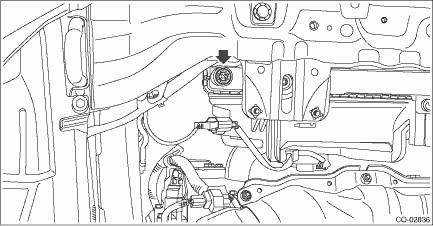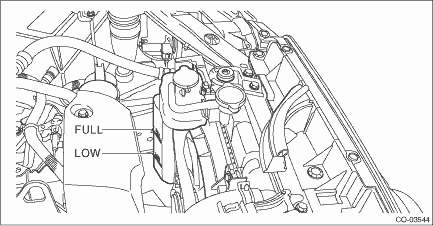Subaru Crosstrek Service Manual: Replacement
COOLING(H4DO) > Engine Coolant
REPLACEMENT
1. DRAINING OF ENGINE COOLANT
1. Turn the ignition switch to OFF.
2. Lift up the vehicle.
3. Remove the under cover. Front Under Cover > REMOVAL">
4. Remove the drain plug to drain engine coolant into container.
NOTE:
Remove the radiator cap so that engine coolant will drain faster.

5. Install the drain plug.
NOTE:
Use new O-rings.
6. Install the under cover. Front Under Cover > INSTALLATION">
2. FILLING OF ENGINE COOLANT
CAUTION:
For CVT models, set the select lever to “P” or “N” range (for MT models, the shift lever in neutral) during work, and do not shift the lever.
1. Pour cooling system conditioner through the filler neck.
Cooling system protective agent:
Refer to “SPECIFICATION” for cooling system protective agent. General Description > SPECIFICATION">
2. Pour engine coolant into the radiator up to the filler neck position.
Recommended engine coolant:
Refer to “SPECIFICATION” for recommended engine coolant. General Description > SPECIFICATION">
Engine coolant level:
Refer to “SPECIFICATION” for engine coolant level. General Description > SPECIFICATION">
Engine coolant concentration:
Refer to “ADJUSTMENT” for the recommended engine coolant concentration. Engine Coolant > ADJUSTMENT">
NOTE:
The SUBARU Super Coolant contains anti-freeze and anti-rust agents, and is especially made for Subaru engines with an aluminum cylinder block. Be sure to use SUBARU Super Coolant, since other coolant may cause corrosion.
3. Fill engine coolant into the reservoir tank up to “FULL” level.

4. Close the radiator cap and start the engine. Race 5 to 6 times at 3,000 r/min or less, then stop the engine. (Complete this operation within 40 seconds.)
5. Wait for one minute after the engine stops (ignition OFF), and open the radiator cap. If the engine coolant level drops, add engine coolant into radiator up to the filler neck position.
6. Perform the procedures 4) and 5) again.
7. Attach the radiator cap and reservoir tank cap properly.
8. Start the engine and operate the heater at maximum hot position and the blower speed setting to “LO”. (A/C OFF)
9. Run the engine at 3,000 r/min or less until radiator fan starts and stops.
NOTE:
Be careful with the engine coolant temperature to prevent overheating.
10. Stop the engine (ignition OFF) and wait until the engine coolant temperature lowers to 30°C (86°F) or less.
11. Open the radiator cap. If the engine coolant level drops, add engine coolant into the radiator up to the filler neck position and the reservoir tank to “FULL” level.
12. Attach the radiator cap and reservoir tank cap properly.
13. Set the heater setting to maximum hot position and the blower speed setting to “LO” and start the engine. Perform racing at 3,000 r/min or less. If the flowing sound is heard from the heater core, repeat the procedures from step 9).
 Adjustment
Adjustment
COOLING(H4DO) > Engine CoolantADJUSTMENT1. PROCEDURE TO ADJUST THE SUBARU SUPER COOLANT CONCENTRATIONCAUTION:Use the SUBARU Super Coolant with a 50 — 60% concentration in order to obtain maximum ...
 Inspection
Inspection
COOLING(H4DO) > Engine CoolantINSPECTIONNOTE:When adding the engine coolant, always use SUBARU Super Coolant.1. Park the vehicle on a level surface.2. Turn the ignition switch to OFF.3. Check the e ...
Other materials:
Note
EyeSight > EyeSight SystemNOTEFor procedure of each component in the EyeSight system, refer to the respective section.• Control module: Control Unit">NOTE:System control of the EyeSight is performed by each module. For procedure, refer to the following sections.– Engine control ...
Dtc b1430 in-vehicle (post evaporator) temperature sensor circuit open
HVAC SYSTEM (AUTO A/C) (DIAGNOSTICS) > Diagnostic Procedure with Diagnostic Trouble Code (DTC)DTC B1430 IN-VEHICLE (POST EVAPORATOR) TEMPERATURE SENSOR CIRCUIT OPENDTC detecting condition:In-vehicle sensor circuit is open.Trouble symptom:In-vehicle air temperature is falsely recognized as 25& ...
Inspection
TELEMATICS SYSTEM (DIAGNOSTICS) > Diagnostics with PhenomenonINSPECTION1. THE SYSTEM DOES NOT NOTIFY THE TELEMATICS SERVICE PROVIDER CENTER AUTOMATICALLY AFTER COLLISIONNOTE:Perform the diagnostics for "Phone conversation is not possible. (The microphone does not respond to a voice. No sound ...
